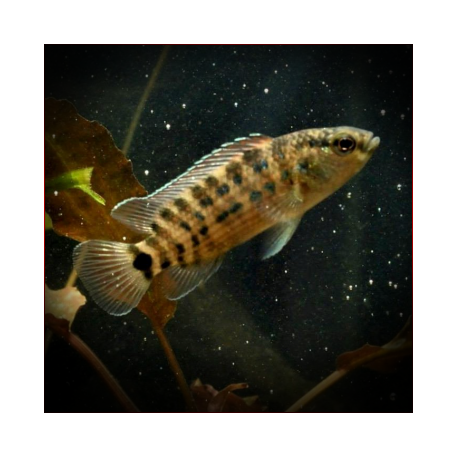More info
Datasheet
| Minimum Tank Size | 90 litres / 23.78 US gallons |
| Maximum Size | 7.0cm / 2.76inches |
| Temperature | 15°C / 59.00°F - 25°C / 77.00°F |
| Hardness | 3.03dgH / 54ppm - 10.03dgH / 179ppm |
| pH | 6.0-7.5 |
General Description
Badis blosyrus is a lesser-known member of the Badis species, a group of micropredatory fish within the Perciformes order. This species is often confused with B. assamensis due to similar body patterning, but can be differentiated by its slightly smaller size, elongated jaw profile, and other internal meristic characteristics. The Badidae family, to which it belongs, has seen significant taxonomy changes post an extensive revision in 2002, resulting in the identification of multiple new species within the genus.
Aquarium Setup
When setting up an aquarium for Badis blosyrus, a well-structured environment is key. The tank should contain a sand or gravel substrate, water-worn rocks, and pebbles for cover. While plants like Microsorum or Anubias can be added for aesthetics, they are not necessary. It is advisable to incorporate driftwood, branches, floating plants, and leaf litter to mimic a natural habitat. Ample cave-like structures should be provided as potential spawning sites, such as half-coconut shells or upturned clay pots with access holes.
Behaviour
These fish exhibit a shy and slow-moving nature, making them vulnerable to intimidation or food competition from larger or more aggressive tankmates. They are not gregarious and can be aggressive towards rival males, especially in smaller tanks. Adequate space and visual barriers are essential for multiple males to coexist peacefully. During breeding, males display intense territorial behavior and vibrant color changes to court females.
Feeding and Diet
Badis blosyrus are micropredators feeding on small aquatic crustaceans, worms, insect larvae, and zooplankton. While they may not readily accept dried foods, offering live or frozen fare like Artemia and Daphnia is crucial for optimal color and health. These fish are deliberate feeders and can develop obesity and health issues if fed certain foods like chironomid larvae.
Reproduction & Dimorphism
For breeding, maintaining the upper range of recommended temperatures and providing caves for spawning are vital. Males may become combative during breeding, displaying courtship behaviors towards females. After spawning, males guard eggs and fry diligently, fending off intruders and caring for the brood. Sexual dimorphism is evident, with males developing extended finnage and brighter coloration compared to females.
Habitat and Distribution
Badis blosyrus is primarily found in the Raidak River of western Assam state, northern India, and Buxa National Park in West Bengal. It thrives in shallow, cool, flowing waters with rocky substrates and marginal vegetation. Sympatric species include Amblyceps, Garra, Psilorhynchus, and Schistura species, along with shrimp and pipefish. The species has also been spotted in streams of the western Garo Hills in Meghalaya state.

